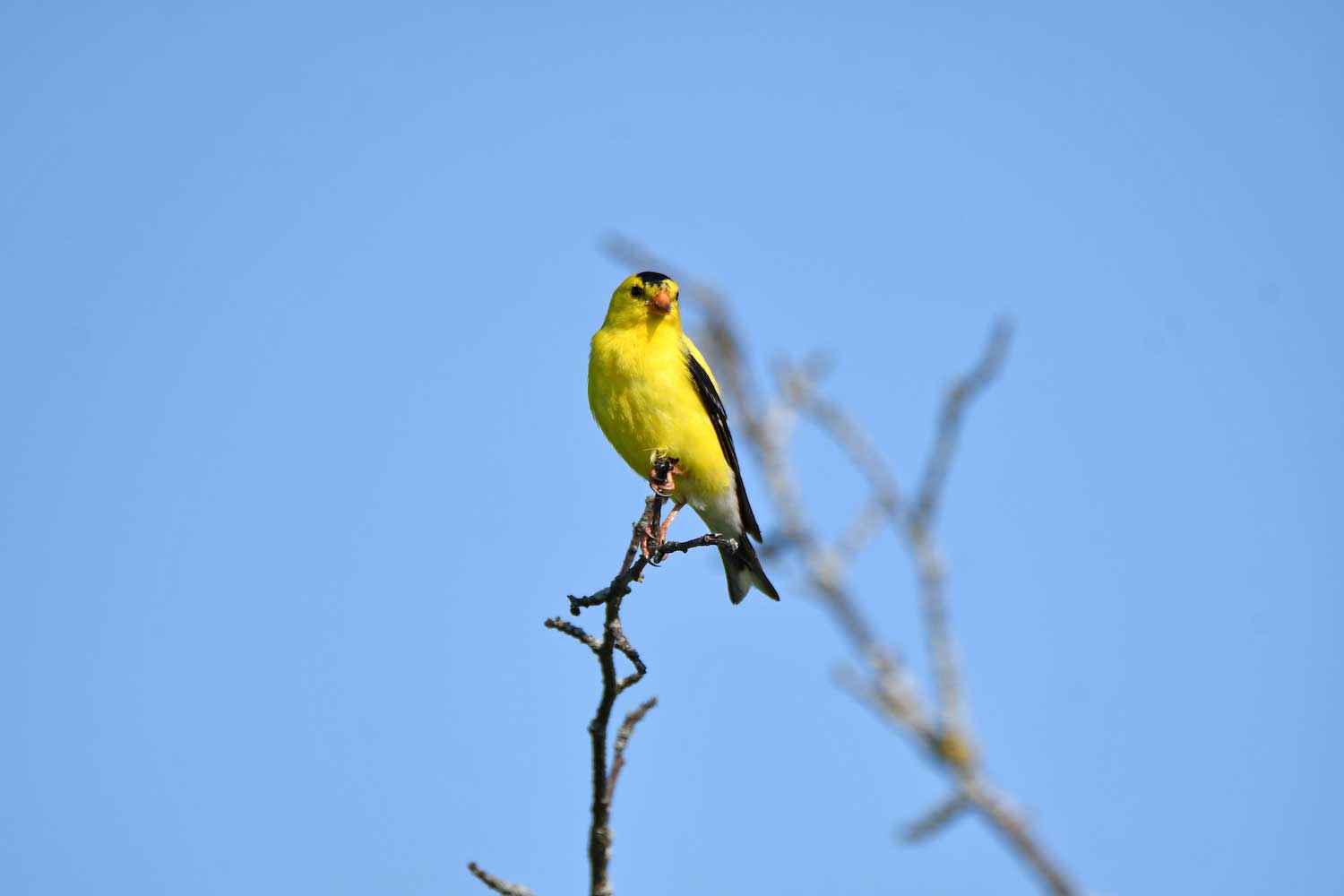Mellow yellow: Delightful goldfinches a common sight

You don't have to be a birding expert to know a goldfinch when you see one. Their name gives them away.
Goldfinches are named for their golden yellow plumage, and their yellow color is also the root of a common nickname, wild canary. This nickname arose because goldfinches' bright yellow color is reminiscent of domestic canaries, a related bird that is commonly kept as a pet.
Goldfinches certainly aren't the only yellow bird we see in Illinois, but it you spot a flash of yellow flying by there's a good chance it is an American goldfinch. These birds are present in Illinois all year long, and they are common too. But not all goldfinches are yellow, and the ones that are aren't always yellow.
Like many songbirds, males and females have quite different appearances. It's the males that have the namesake golden yellow plumage, with black wings and foreheads, according to the Cornell Lab of Ornithology. Females are less flashy, mostly olive or drab brown in color with some flashes of dull yellow. That's the summer plumage for these birds, though. In the winter, both birds are less colorful in appearance and look more similar to one another. They maintain their dark-colored wings, but they are otherwise mostly drab brown in color.
These color changes occur when the birds molt, and unlike most birds, goldfinches molt twice a year instead of just once, the Cornell Lab reports. During the first molt, in late winter, the male finches acquire their bright yellow feathers. Because of the timing, people often consider the return of golden yellow goldfinches to be a sign that spring is coming. The second molt occurs late in the summer, when the birds change over to their more dull appearance.
If their colorful plumage doesn't catch your eye, their flight pattern might. Goldfinches look like they are bouncing up and down, or cruising along on the hills of a roller coast, as they move up and down and up and down as they fly, the Cornell Lab reports. They also call out in flight, with it said to sound like they are singing out po-ta-to-chip with the syllables repeated in rapid succession as they rise and fall.
Goldfinches live across the entire United States as well as parts of Mexico and Canada. They can be found in many different types of habitats, including forests, fields and grasslands, shrub lands and urban and suburban areas, according to the Illinois Department of Natural Resources.
While many songbirds have a varied diet that includes plant and animal matter, goldfinches are strictly seed eaters. Any insects they consume are just inadvertent, catching them unintentionally in flight, the Cornell Lab of Ornithology reports. They prefer seeds from flowers like asters, sunflowers and thistles, and it's not uncommon to see them perched atop coneflowers in search of seeds. They also eat seeds from grasses and trees.
At bird feeders, you're likely to have luck attracting goldfinches with sunflower and nyjer feeders. Because they will eat seed from the ground, it's important to rake up excess spilled seed to prevent the spread of contagious diseases among birds, the Cornell Lab advises.
These birds have a few adaptations that make their seed-eating lifestyle a lot easier. First, they have large, cone-shaped bills that make it easy to crack into seeds, according to the American Bird Conservancy. They are also very dexterous, which allows them to easily cling to seed heads as they feed on seeds, even as they sway in the breeze.
Goldfinches nest very late in the season, usually starting their nesting activity when other birds are finishing raising their broods, according to the American Bird Conservancy. They typically nest and raise their young from July to September, and this timing is no coincidence. At this time of year, the seeds they rely on to eat are plentiful.
Another reason a late nesting season works to their advantage is because they incorporate plant fibers into their woven nests, the Cornell Lab reports. It's not uncommon to see goldfinches visiting plants like milkweed and thistle in the summer not just for the seeds but for the stringy plant material they use in their nests.
They typically nest in shrubs, and it's the females that construct the nests, building for about six days. They will then lay between two and seven eggs and incubate them for about two weeks before they hatch. The young birds stay in the nest for up to 17 days before fledging.
While many birds have seen their population drop because of human activity, goldfinches have not suffered such drastic consequences. These birds prefer the open, weedy areas that develop when trees are cut from land because it provides good habitat and an ample food supply, the American Bird Conservancy reports. They are still vulnerable to other human effects such as pesticide use, cars and window collisions.
Although they remain common across their range, the goldfinch population has declined by 27% since 1966, the Cornell Lab reports. Despite the decrease, they are considered a species of low conservation concern.
The finch family of birds includes many colorful and familiar species, including scarlet tanagers, indigo buntings, northern cardinals, rose-breasted grosbeaks and house finches, the Cornell Lab reports. One of the hallmarks of the finch family is a large, cone-shaped bill that is useful for eating seeds, but unlike goldfinches, many birds in the finch family also consume insects along with seeds.
